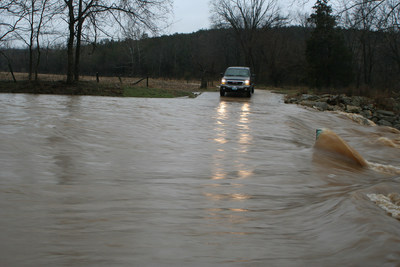Oklahoma
New Climate Modeling Predicts Increasing Occurrences of Flash Flooding Across Most of the U.S.
NORMAN, Okla., April 26, 2022 /PRNewswire/ -- The latest U.N. report on climate change documented researchers' efforts that have shown some measures of global warming are now unavoidable, and current research efforts are focusing on mitigation and adaptation strategies. The National Aeronautics and Space Administration describes this as a global problem, felt on local scales. Likewise, National Oceanic and Atmospheric Administration researchers are providing the data, tools and information to better understand and prepare for climate change. One of the effects being impacted by the warming climate is a change in frequency of flash flooding events, as well as the locations in which they most often occur.
A research team led by the University of Oklahoma, with the NOAA National Severe Storms Laboratory and collaborators at the National Center for Atmospheric Research, have created simulations from coupled climate and hydrologic models that demonstrate widespread increases in the occurrences of flash flooding events across most of the United States.
The study is led by Yang Hong, a professor of hydrology and remote sensing in the School of Civil Engineering and Environmental Sciences and in the School of Meteorology at OU. He is the director of the Hydrometeorology and Remote Sensing Laboratory and the founding director of the hydrology and water security online master's program at OU. The research team's findings are published in Nature: Communications Earth and Environment. Zhi Li, a doctoral student with the HyDROS Lab, is the first author.
"This study builds upon the state-of-the-art model (EF5/CREST) that is jointly developed by researchers with OU, NASA, and NOAA's National Severe Storms Laboratory and has initiated collaboration with National Center for Atmospheric Research climate scientists," said Li. "It realizes the concept of 'Digital Twin in Earth System Science,' in which one is our living climate and the other one is our future. Climate change never became so real to me until we successfully collaborated on such research."
"There hasn't been a real definitive study on what's going to happen with flash floods in the future," said Jonathan J. Gourley, research hydrometeorologist with the NOAA National Severe Storms Laboratory and contributor to the study. "We didn't have that robust of an observational record so, this study helped to fill in that gap. By using some of the rainfall simulations from a convection-resolving climate model and then coupling with our high-resolution hydrologic modeling system, we can see what sort of flash floods would be produced in the future."
The research team used climate simulations and modeling of a 30-year period, 2070-2100, to predict the location and degree to which flash floods are likely to occur. The effect, what the researchers call "flashiness," describes the likelihood of weather conditions that can cause rapid rainfall and lead to flash flooding.
They found that, if emissions continued at their current rate, flooding events would become 7.9% "flashier" by the end of the century, meaning heavy rainfall events are likely to occur quickly and in concentrated areas that are likely to lead to flooding.
Similarly, their results show a more than 10% increase in flash flooding in the Southwest U.S., the greatest increase in "flashiness" among historical flash flood hot spots. The central U.S. is emerging as a new flash flood hotspot as well, with an 8.6% predicted increase. Overall, their results show future flash flood-prone regions are moving northwards.
"More people will have to learn not just how to survive floods but also how to better live with ever-increasing flash floods," said Hong. "The 20-year return floods will more likely occur every two to five years, especially alarming for the emerging flashiness hotspots that will be facing unprecedented challenges with aging infrastructure and outdated flood risk measures. There is a pressing need to implement climate-resilient engineering infrastructure and develop smart hydrological early warning systems."
However, there is still time to curb some of the more extreme impacts. Gourley says climate mitigation strategies could help.
"Now's the time to start thinking about better flood defenses," he said. "Of course, decreasing greenhouse gas concentrations would be the ultimate solution, but in the meantime, we can think about ways to reduce vulnerabilities and improve flash flooding safety education."
"The majority of fatalities related to flash floods are not floods finding people, but people finding floods, meaning they're out and about," he added. "They're typically driving through a flooded roadway."
The best way to stay safe during flash flooding events is to stay off the roads and avoid standing water.
"The conterminous United States are projected to become more prone to flash floods in a high-end emissions scenario," was published April 6, 2022, in the journal Nature: Communications Earth and Environment, DOI:10.1038/s43247-022-00409-6
Image Credit
Photo of a truck on a flooded roadway, taken by Joe Lawton. Image credit NOAA NSSL.
About the University of Oklahoma Office of the Vice President for Research and Partnerships
The University of Oklahoma is a leading research university classified by the Carnegie Foundation in the highest tier of research universities in the nation. Faculty, staff and students at OU are tackling global challenges and accelerating the delivery of practical solutions that impact society in direct and tangible ways through research and creative activities. OU researchers expand foundational knowledge while moving beyond traditional academic boundaries, collaborating across disciplines and globally with other research institutions as well as decision makers and practitioners from industry, government and civil society to create and apply solutions for a better world. Find out more at ou.edu/research.
About the University of Oklahoma
Founded in 1890, the University of Oklahoma is a public research university located in Norman, Oklahoma. OU serves the educational, cultural, economic and health care needs of the state, region and nation. For more information visit www.ou.edu.
![]() View original content to download multimedia:https://www.prnewswire.com/news-releases/new-climate-modeling-predicts-increasing-occurrences-of-flash-flooding-across-most-of-the-us-301533502.html
View original content to download multimedia:https://www.prnewswire.com/news-releases/new-climate-modeling-predicts-increasing-occurrences-of-flash-flooding-across-most-of-the-us-301533502.html
SOURCE University of Oklahoma


